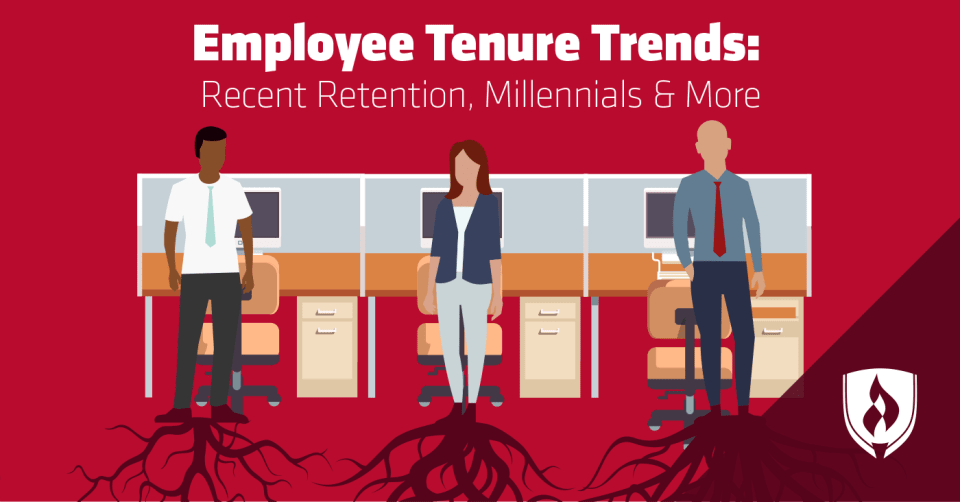
How long have you worked for your current employer? Believe it or not, if you’ve reached the five-year mark, then you’ve already been around longer than the average American stays with the same company.
In an increasingly digital economy that is constantly evolving and becoming progressively more competitive, strong tenure can be difficult to achieve. In fact, the median number of years salaried workers had been with their current employer was 4.2 as of January 2018—down slightly from 4.6 years in January 2014, according to the Bureau of Labor Statistics.1
While that overarching finding seems straightforward enough, you may be surprised to learn how much there is to unpack within that statistic. Consider, for example, the following questions:
What role does something like gender play in employee tenure?
What about age—how are Millennials faring in comparison to their preceding generations?
Are there also notable conclusions to be made based on ethnicity, education or industry?
And, finally, what can employers do with this valuable information?
Read on as we dig into the latest reports and uncover answers to these important questions.
What is tenure? How the latest stats fare
Information on employee tenure has been obtained by the Current Population Survey (CPS) every two years since 1996 through monthly sample surveys of approximately 60,000 households. As the BLS reports on its notable findings, there is a bevy of valuable information to sift through.
Employee tenure is defined as the length of time workers have been in their current job or with their current employer. Examining the varying aspects of things like employee turnover and retention rate can help illuminate important trends within the economy at large, specific industries and even singular companies, often highlighting potential areas for improvement.
The most recent national report was released by the BLS in 2018. The following facts were determined:1
Employee tenure by gender
In general, average employee tenure has seen a decline since 2014. The average amount of time American men had been with their current employer in 2018 was 4.3 years—unchanged from 2016 and down slightly from 4.7 years in 2014. Women in the U.S. saw a marginally larger decline in recent years, dropping from 4.5 years in 2014 to 4.0 years in 2018.
The numbers stay pretty comparable when we zoom out to examine the trends among longer-tenured employees. Among women, 28 percent had 10 years or more of tenure with their current employer in 2018. For men, the percentage sits a little higher at 30.
Employee tenure by age
As has been the trend in past reports, median employee tenure was generally higher among older workers than younger workers in 2018. For example, median tenure among 55- to 64-year-old workers (10.1 years) was more than triple that of workers ages 25 to 34 (2.8 years).
This may, on its surface, appear to justify the claim that millennials have garnered a reputation as “job-hoppers” who display a lack of commitment to a single organization. But a deep dive into the data reveals that young employees today actually stay longer with a single company than employees of the same age group did 25 years ago.
Employee tenure by ethnicity
Discrepancies in employee tenure are also found among the major race and ethnicity groups in America. Consider the following facts as they relate to the number of eligible workers who were, at the time of the 2016 report, employed by an organization with whom they’d worked for at least 10 years:
- 23 percent of Hispanic workers
- 25 percent of Black workers
- 25 percent of Asian workers
- 30 percent of White workers
Experts have explained the significantly lower percentage of long-tenured Hispanic workers by citing the relative youth of the Hispanic population in America. Younger people have, on average, shorter tenures across the board—so a young population can skew things statistically.
Employee tenure based on education
The amount of formal education members of the workforce have received is another interesting variable in the statistics surrounding employee tenure in America. Among workers aged 25 or older, those who’d obtained less than a high school diploma had lower median tenure than those with more education.
Men with less than a high school diploma, for example, saw a median tenure of 4.7 years, while women with the same qualifications landed closer to 4.2 years. Add in at least a college degree, and the median tenure jumped to 5.2 years and 5.0 years, respectively.
Employee tenure based on industry
While there are some statistics surrounding job- or industry-specific employee tenure—such as the fact that management positions see the highest median tenure at 6.4 years, while food service workers experience the lowest at 1.9 years—the more compelling data is found in the discrepancy between private- and public-sector workers.
Standing as one of the largest divergences in the entire report, public-sector employees—or employees who work in an industry that is tax-payer funded and service driven, such as teachers, police officers and other government employees—had a substantially longer median tenure than their private-sector counterparts. The median tenure for private-sector workers sits at 3.8 years while public-sector workers’ median tenure is a full three years longer at 6.8 years.
In the public sector, federal employees saw the highest median tenure at 8.3 years, while median state government employee tenure was 5.9 years. In the private sector, the manufacturing industry reported the highest median tenure among private-sector workers, with five years, while workers from the leisure and hospitality fields produced the lowest median tenure at 2.2 years.
What the facts about employee turnover really tell us
Experts have spent ample time analyzing the information gathered by the CPS as it relates to employee tenure in America. As such, a few conclusions have been made about the varying trends that were identified.
An overarching summary can tell us, for example, that “career” jobs that span an entire working life weren’t common for most workers in the early 80s, and they have continued to be uncommon for most workers. This flies in the face of the conventional wisdom that job hopping is some new trend for this generation of workers.
It’s also interesting to note that distinct correlations have been identified between a decreased unemployment rate and shorter employee tenures. That is to suggest that a decrease in unemployment can result in workers feeling more comfortable with or empowered by the idea of changing jobs to pursue what might be considered riskier opportunities in a struggling job market.
Because millennials currently account for the largest portion of the American labor force, it can be helpful to examine the reasons they provide for having left an employer for a more promising opportunity. While they may not be the job-hoppers they’ve been pegged as, Deloitte’s 2016 Millennial Survey revealed that they are more likely to move from one opportunity to the next if they don’t feel empowered to achieve the levels of career success they’re chasing at their current organization.
In fact, more than six in 10 millennials reported feeling that their leadership skills were not being developed fully within their current positions, and they look for organizations with a vested interest in professional development, according to the survey.2
Finally, the notable discrepancy between public- and private-sector workers also reveals a lot about employee motivation to remain committed to a single organization. The contrasting results in median employee tenure, many argue, have everything to do with the way the government holds itself to a higher standard when it comes to how it treats its workers. This can be displayed by elements like fairer wages, retirement benefits, pensions and healthcare.
Learn more about employment trends
Are you fascinated by the granular details of employment and hiring trends in the U.S. and beyond? Or maybe you’re more interested in the psychology of the average American employee, eager to understand what motivates their decision-making process. It’s also possible that you’re motivated by the mission of employee satisfaction, and you’re curious about the current qualms that exist in today’s workforce.
Whatever it is that draws you into this topic, know that there are a number of different ways you can convert your curiosity into a career. If you’re pulled in by the idea of working at the heart of an organization to support both the talent and health of your company, you might want to consider pursuing a career in human resources. Not sure if that sounds right for you? Our article, “7 Signs You Should Be Working in HR,” can help!
1Bureau of Labor Statistics, U.S. Department of Labor, Employee Tenure Summary 2018 [information accessed September 25, 2018] https://www.bls.gov/news.release/tenure.nr0.htm. Information represents national, averaged data and includes workers at all levels of education and experience. Employment conditions may vary in your area.
2Deloitte, 2016 Deloitte Millennial Survey [information accessed September 25, 2018] https://www2.deloitte.com/content/dam/Deloitte/at/Documents/human-capital/millennial-innovation-survey-2016.pdf




